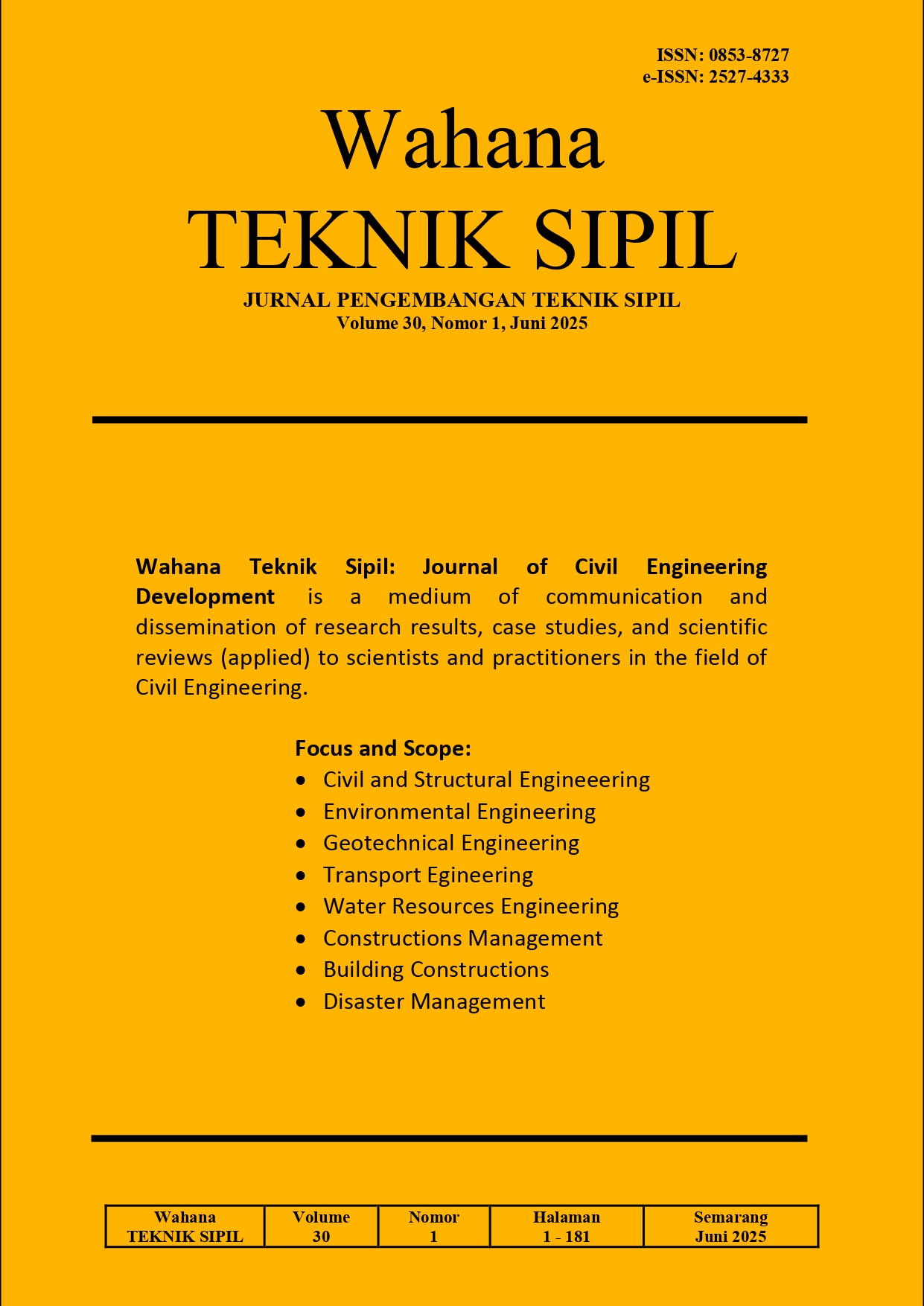INOVASI MATERIAL GEOSINTETIK (GEOCELL) DAN KIMIA (GEOPOLL) UNTUK OPTIMALISASI PERBAIKAN JALAN HAULING DI PT. MARUWAI COAL
DOI:
https://doi.org/10.32497/wahanats.v30i1.6180Keywords:
Hauling Production, Geocell, Geopoll, Road Maintenance ApplicationAbstract
PT Maruwai Coal faces challenges in increasing hauling production efficiency due to the decline in the quality of hauling roads. In April 2023, dump truck traffic only reached 1.58 cycles/shift, far below the target of 2 cycles/shift, causing a production loss of 26% (91,280 tons). This condition is influenced by the decline in the quality of hauling roads, which is reflected in the Coal Hauling Road Index (CHRI) value which only reached 81.02% in the 17th week of 2023, far below the standard of 90%. Decreased road performance results in increased travel time, maintenance costs, and faster vehicle damage. This research aims to apply the principles of geosynthetic (geocell) and chemical (geopoll) materials in improving transport roads. In addition, the Road Maintenance application is used to maintain road conditions, provide recommendations for repairs, and ensure proper implementation of SOPs. A case study was carried out on Segment 4 (KM39”“KM52) by measuring changes in CHRI values, average speed and production results. The application of geocell increased the CHRI value from 83% to 91.23% and extended the life of the road by more than 8 weeks. The use of geopoll increases the bearing capacity of the soil, reduces installation and maintenance costs by 21.95%, and increases the average speed from 35.08 km/h to 38.66 km/h. Production increased from 362,419 tonnes/month to 397,337 tonnes/month, resulting in increased profits of $8,243,790 per month. This research shows that geocells, geopolls and digital applications significantly improve cost efficiency, road performance and support production sustainability at PT Maruwai Coal. This study makes a real contribution to the development of infrastructure technology.
References
Atkinson, T., Design and Layout of Haul Roads, SME Mining Engineering Handbook. 2nd Edition, Littlelon, CO : SME 1992.
Bayraktar, O. Y. (2020). Use of geosynthetics in road construction. KUJES, 6(2), 107”“113. (https://www.researchgate.net/publication/347843679).
Becker, Gary S. 1993 Human Capital, A Theoretical and Empirical Analysis, With Special Reference to Education. University of Chicago.
Bhange, N. A., & Nandagawali, P. R. (2020). Use of geocell in road construction. Journal of Analysis and Computation (JAC). Proceedings of the National E-conference on "Research & Innovation, 2020". (Retrieved from http://www.ijaconline.com).
Bhatia, S.K., Dash, S.K., dan Rajagopal, K. (2018). Field performance of geocell reinforced unpaved roads over soft soil. Geotextiles and Geomembranes, 46(1), 68-78.
Herdiansyah, S., Zaenal, dan Iswandaru. (2022). Kajian Teknis Geometri Jalan Tambang untuk Mengurangi Dampak Slippery sebagai Upaya Meningkatkan Produksi Nikel PT ANTAM (Persero) Tbk di Kecamatan Maba, Kabupaten Halmahera Timur, Provinsi Maluku Utara. Bandung Conference Series: Mining Engineering, 2(2), 441”“447. https://doi.org/10.29313/bcsme.v2i2.4018)
Keputusan Menteri Energi dan Sumberdaya Mineral Republik Indonesia No. 1827 K/30/MEM/2018 Tentang “Pedoman Pelaksanaan Kaidah Teknik Pertambangan Yang Baik”.
Sidabutar, G. (2019). Metodologi Perancangan Jalan Angkut Batubara Dari Aspek Sipil Dan Manajemen Keselamatan Di Pt Lahai Coal. Prosiding Temu Profesi Tahunan PERHAPI, 1(1), 61”“74. (https://doi.org/10.36986/ptptp.v0i0.6)
Suwandhi, A. (2004). Perencanaan jalan tambang, (1-25). Diktat Perencanaan Tambang Terbuka. Unisba.
Tampubolon, E., dan Dwito., AH. (2023). Optimization of effective working hours for coal transportation from ROM to Port : Study at PT. Maruwai Coal Central Kalimantan. (https://doi.org/10.1051/bioconf/20248906002)
Downloads
Published
Issue
Section
License
Copyright (c) 2025 Wahana Teknik Sipil: Jurnal Pengembangan Teknik Sipil

This work is licensed under a Creative Commons Attribution 4.0 International License.
Authors who publish with this journal agree to the following terms:Authors retain copyright and grant the journal right of first publication with the work simultaneously licensed under a Creative Commons Attribution License that allows others to share the work with an acknowledgement of the work's authorship and initial publication in this journal.
Authors are able to enter into separate, additional contractual arrangements for the non-exclusive distribution of the journal's published version of the work (e.g., post it to an institutional repository or publish it in a book), with an acknowledgement of its initial publication in this journal.
Authors are permitted and encouraged to post their work online (e.g., in institutional repositories or on their website) prior to and during the submission process, as it can lead to productive exchanges, as well as earlier and greater citation of published work (See The Effect of Open Access).






